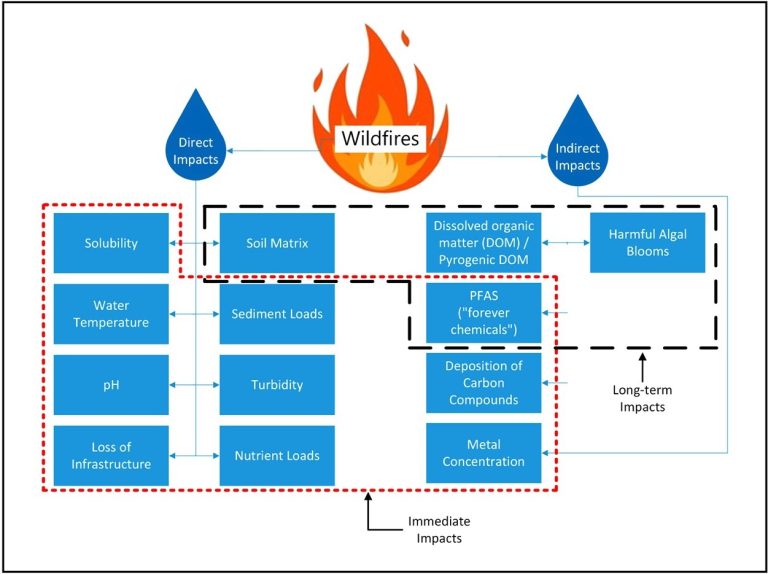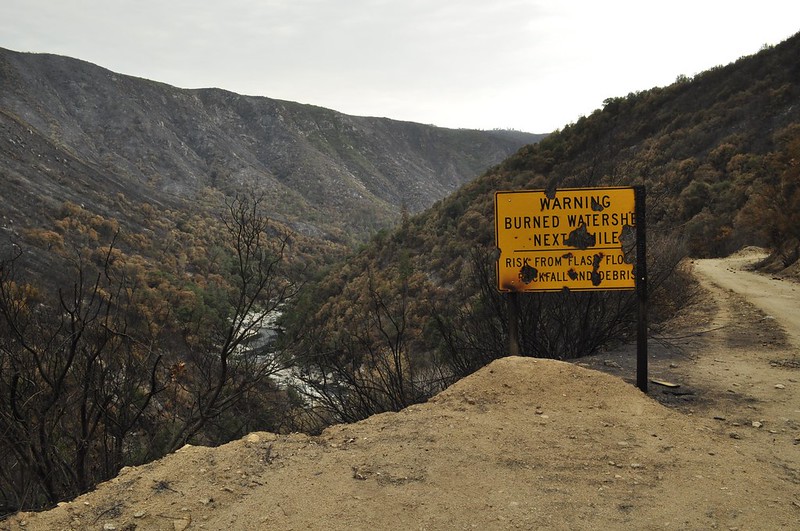Wildfires not only ravage land but also have far-reaching and profound effects on water systems. By stripping away vegetation, they leave soil vulnerable to erosion, while ash, debris, and harmful contaminants are washed into rivers, lakes, and reservoirs, severely degrading water quality.
These impacts pose significant risks to the environment and communities’ health and water security. As climate change fuels wildfires’ increasing frequency and intensity, innovative solutions become more critical than ever. exci’s AI-powered early wildfire detection technology is vital for mitigating wildfires, preventing them from escalating and safeguarding essential water resources. In this blog post, we examine the damaging effects of wildfires on water systems and how exci’s cutting-edge technology can mitigate these threats.
How Wildfires Affect Water Systems
Wildfires can severely impact the water cycle and water quality. They eliminate plants and trees that once helped stabilise soil, absorb rainwater, and filter out contaminants. This has profound consequences for water systems.
Increased Sedimentation and Soil Erosion
Wildfires leave the land more prone to erosion by removing the vegetation that normally holds the soil in place. After the fire, loose sediment is washed into nearby rivers and streams when it rains. This influx of sediment can clog waterways, damage aquatic habitats, and alter the natural flow of streams and rivers. The effects of this sedimentation also extend to human populations, making water treatment much more challenging and costly.
Communities that rely on untreated or minimally treated natural water sources are especially at risk. The increased sediment load requires additional treatment processes, driving up costs and reducing the availability of clean drinking water.
Toxic Contaminants
Wildfires can release harmful chemicals into water supplies in addition to sediment. Burning infrastructure often contains hazardous substances, such as heavy metals (e.g., mercury, lead, polycyclic aromatic hydrocarbons (PAHs), and arsenic), which can leach into rivers and reservoirs after a fire. These substances can reduce water clarity, increase turbidity, and lower oxygen levels, posing a serious threat to human health and the environment.
For drinking water utilities, filtering out these toxins becomes an urgent priority, but the treatment process is often complex and expensive. Smaller communities with fewer resources may face significant challenges in restoring safe drinking water, leading to prolonged disruptions and health risks.
 Impacts of wildfires on water sources. Source US Fish and Wildlife Service
Impacts of wildfires on water sources. Source US Fish and Wildlife Service
Wildfires Threaten Water Supply and Infrastructure
Wildfires not only threaten water quality but also impact water availability. In regions where water is already scarce, the consequences of a wildfire can be severe.
Destruction of Watersheds: A watershed is a natural drainage area collecting and storing water from rain or snowmelt. When wildfires burn through these areas, they diminish the land’s ability to absorb and filter water. This can lead to reduced groundwater recharge, resulting in long-term decreases in water supply. Burned areas also become more susceptible to flash flooding and mudslides, complicating water management efforts.
 Watershed after Fire. Source: Flickr by BLMIdaho Fire
Watershed after Fire. Source: Flickr by BLMIdaho Fire
Damage to Water Infrastructure: Wildfires can damage critical infrastructure, including pipelines, reservoirs, and water treatment facilities. For example, fires near urban areas can disrupt or contaminate municipal water supplies, leading to temporary shortages or boil-water advisories. Additionally, power outages caused by fires can hinder water treatment processes, leaving communities vulnerable.
Disruptions to the Hydrological Cycle: The loss of vegetation caused by wildfires disrupts the local hydrological cycle. Forests and plants play a vital role in regulating water by intercepting rainfall and releasing moisture into the atmosphere through transpiration. When wildfires destroy large forest areas, these natural processes are disrupted, leading to altered precipitation patterns, decreased soil moisture, and reduced water availability.
Wildfire-Contaminated Water: Community Risks
Water contamination following a wildfire affects people in multiple ways, with risks to health and livelihoods.
Health Hazards
Contaminated water presents numerous risks to human health, particularly from exposure to heavy metals and other toxic substances. Ingesting these contaminants can lead to a variety of illnesses, ranging from mild gastrointestinal issues to more severe problems such as organ damage, neurological disorders, or even cancer.
Moreover, while fire retardants are essential for containing wildfires, they can add additional chemicals to the water system. Mixing these substances with wildfire runoff exacerbates water quality issues, increasing the strain on treatment systems.
Economic Impacts
The economic costs of wildfire-related water contamination are immense. Water utilities need to invest in additional treatment infrastructure or upgrade existing facilities to handle the increased sediment and toxins. This raises operational costs, which are often passed on to consumers.
Agricultural industries relying on water for irrigation may decrease crop yields due to contamination, while tourism-based economies suffer as recreational waters become unsafe.
Additionally, rebuilding infrastructure and restoring ecosystems damaged by wildfires often requires significant public funding, adding to the long-term financial burden on communities.
The bushfires have significantly impacted fishing industries and aquaculture by degrading water quality and essential habitats. The loss of seagrass meadows and mangroves also reduces the capacity to store blue carbon, exacerbating climate change. Fisheries harmed by bushfire-related pollution may face long-term challenges similar to those caused by catchment clearing and coastal development.
Impact of Wildfire Runoff on Ecosystems
The effects of wildfires on water extend beyond human concerns, affecting entire ecosystems that depend on clean, stable water sources.
Aquatic Ecosystems
Sediment from wildfire runoff can cloud waterways, blocking sunlight and depleting oxygen levels, which disrupts aquatic food chains. Fish and other aquatic species may struggle to survive in these altered conditions, with some populations facing the risk of local extinction. Wildfires also significantly alter the nutrient composition of runoff, as burned vegetation and organic matter release elevated levels of nitrogen and phosphorus into waterways. This nutrient influx, known as nutrient loading, can cause eutrophication, a process that promotes harmful algal blooms (HABs) and destabilises aquatic ecosystems.
Wildfires can significantly alter water temperatures, putting additional stress on aquatic ecosystems. The loss of riparian vegetation, which typically provides shade along stream banks, allows more solar radiation to reach water bodies. This increase in solar exposure raises water temperatures, which can be harmful to temperature-sensitive species like trout and salmon. Warmer water also holds less dissolved oxygen, further exacerbating oxygen depletion and stressing aquatic organisms.
Wildfires also change the physical structure of stream channels. Erosion from fire-affected landscapes can introduce large amounts of sediment into waterways, filling deep pools that serve as cool refuges for fish during warm weather. Landslides and debris flows can alter the course of rivers and streams, affecting flow patterns and the availability of habitats for aquatic species.

Post-Fire Water Quality
Wetland Destruction
Wetlands play a vital role in maintaining water quality by acting as natural filters that trap pollutants before they enter larger water bodies. However, wildfires can damage or destroy wetlands, compromising their ability to protect water systems from contamination. The loss of wetlands further accelerates the decline of biodiversity and weakens the resilience of ecosystems, as these areas serve as critical habitats for numerous species.
Solutions to Reduce the Impact of Wildfires on Water Quality
While wildfires pose significant threats to water quality, there are several effective strategies that can help mitigate their impact. These include both proactive measures to prevent wildfires and post-fire management techniques to restore and protect water systems.
Post-Fire Erosion Control and Sediment Management
Once a wildfire has occurred, one of the most immediate concerns is controlling erosion and managing the sediment that can be washed into water systems during rainstorms. Several techniques can be employed to address this issue:
Erosion Control Measures: Installing barriers such as silt fences, straw wattles, or logs can help slow the movement of sediment-laden water across burned landscapes. These measures reduce sediment entering rivers and reservoirs, minimising the impact on water quality.
Hydroseeding and Mulching: Spreading seeds mixed with water and mulch over the burned area encourages plant growth, helps anchor the soil, and reduces erosion over time.
Sediment Traps and Basins: Sediment basins and traps can be built to capture and retain runoff from burned areas before they enter larger water bodies. These structures allow sediment to settle out of the water, preventing it from flowing into rivers and lakes.
Forestry Management and Controlled Burns
Another essential strategy for protecting water systems is managing forests to reduce the intensity and spread of wildfires. Proper forestry management practices, such as thinning dense forests, removing dead wood, and conducting controlled burns, can lower the risk of large, destructive fires.
Thinning and Fuel Reduction: Removing excess vegetation and thinning dense forests reduces the fuel available to a wildfire. This can help slow the spread of fires and reduce their intensity, limiting the damage to surrounding ecosystems and water systems.
Controlled Burns: Controlled or prescribed burns are intentionally set fires that remove excess fuel from the forest floor in a safe and controlled manner. These burns help reduce the risk of large wildfires by removing materials that could otherwise feed a wildfire. By reducing the size and intensity of fires, controlled burns help protect water systems from the large-scale erosion and sedimentation that typically follow wildfires.
exci’s AI-Powered Wildfire Detection: A Proactive Solution
Early bushfire detection is essential for minimising the impact on water systems, complementing post-fire and forestry management strategies. exci’s AI-powered wildfire detection system offers a proactive approach, helping to mitigate the effects of wildfires on these critical ecosystems.
Using advanced machine learning algorithms, exci’s AI analyses data from cameras and satellites to identify smoke and heat signatures indicative of fire. The AI technology can detect fires as small as a garden shed within minutes, immediately notifying the appropriate responders. By facilitating the rapid identification of fire outbreaks, exci’s system helps contain fires before they escalate, protecting wildlife and their habitats for future generations.
Proudly Australian-made and owned, exci safeguards over 30 million acres across Australia. Since its inception, the system has detected more than 150,000 fires, demonstrating its proven effectiveness in early detection. This early intervention protects communities and natural resources and reduces the risk of post-fire contamination. By stopping fires at their inception, less ash and debris are washed into rivers and lakes, decreasing the environmental and economic costs associated with water treatment and ecosystem restoration.
exci’s AI bushfire detection system integrates seamlessly with local and regional monitoring efforts, offering comprehensive protection for watersheds, agricultural land, and critical water infrastructure. In the face of increasing wildfire risks due to climate change, exci’s solution provides a sustainable method to safeguard vital water resources.
Conclusion
Wildfires have far-reaching consequences on water systems, impacting human health, ecosystems, and local economies. By integrating strategies such as post-fire erosion control, sediment management, and forestry practices with exci’s AI-powered wildfire/bushfire detection technology, we can significantly reduce the harmful effects of wildfires on water systems.
Early fire detection plays a crucial role in reducing the scale of wildfires, limiting the sedimentation and contamination that follow these disasters. As climate change heightens wildfire risks, exci’s innovative solution offers hope for protecting water resources and the communities that depend on them.
by Gabrielle Tylor
exci – Smoke Alarm for the Bush
Wildfire/Bushfire Detection Technology
26 September 2024
Don’t let hazardous events escalate into catastrophes!
Reach out to our friendly team today for a comprehensive demonstration of exci’s system and learn how it can safeguard your assets while protecting your community.
email: info@exci.ai
International Phone: +61 458 594 554
Visit our website at https://www.exci.ai/ to learn more and take the first step towards a safer and more resilient future.

